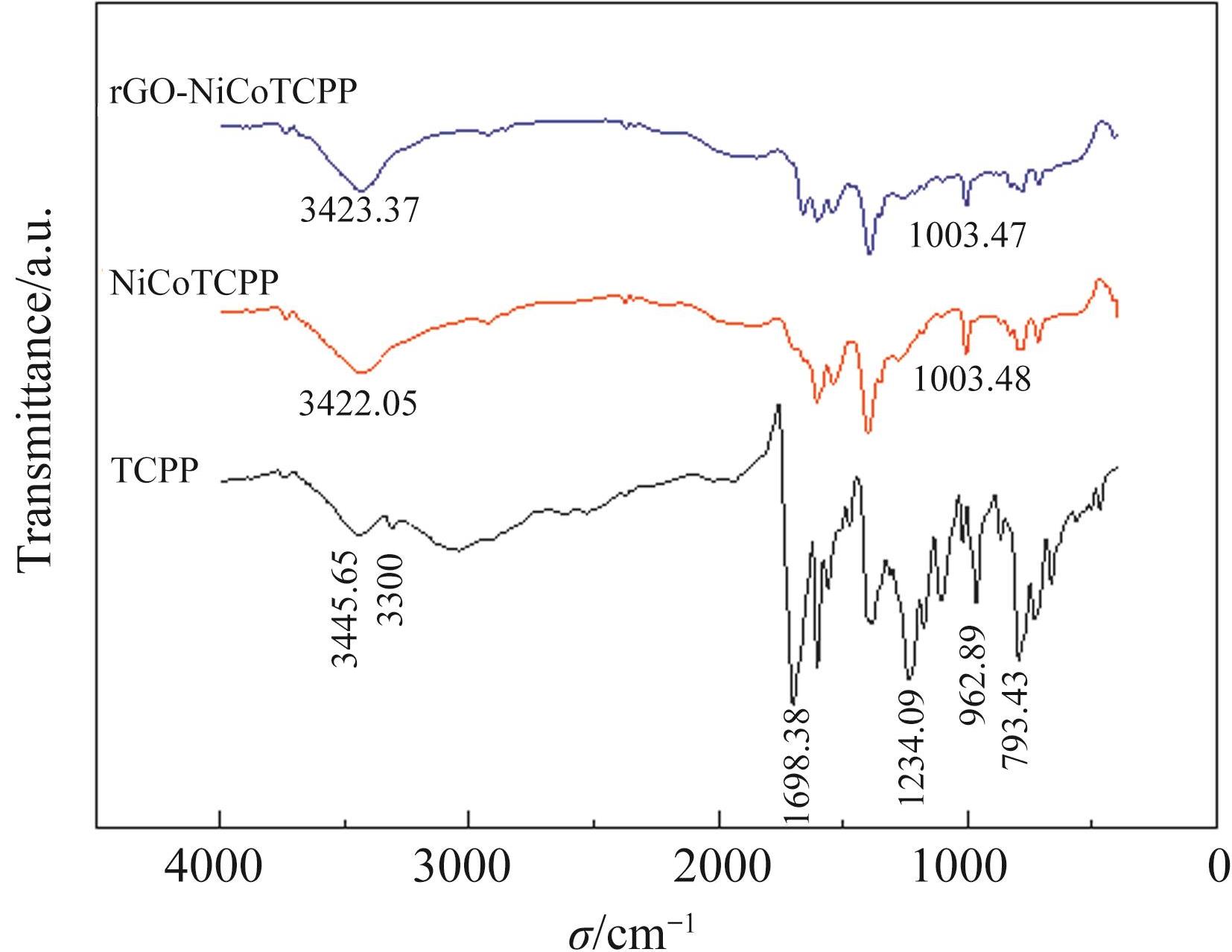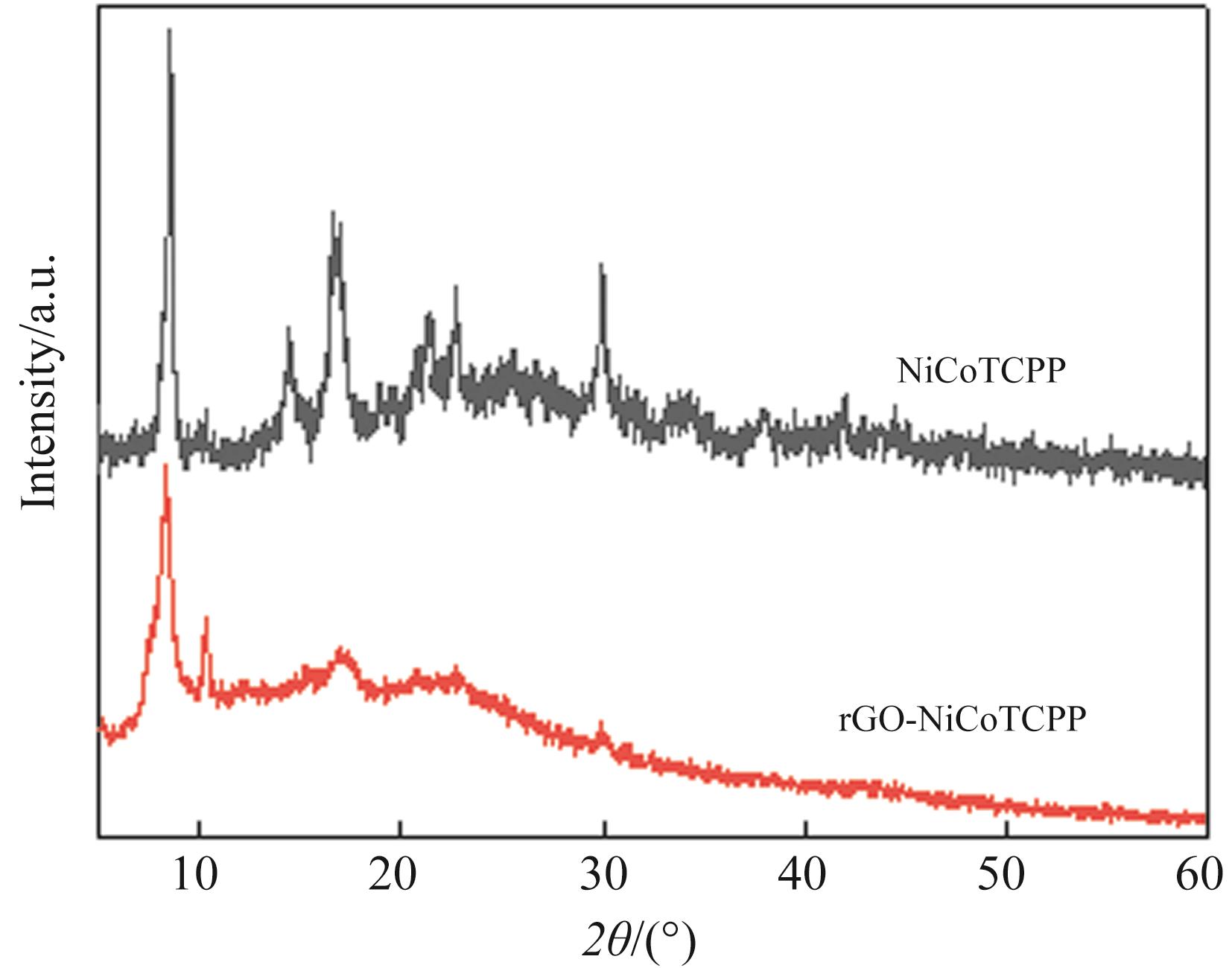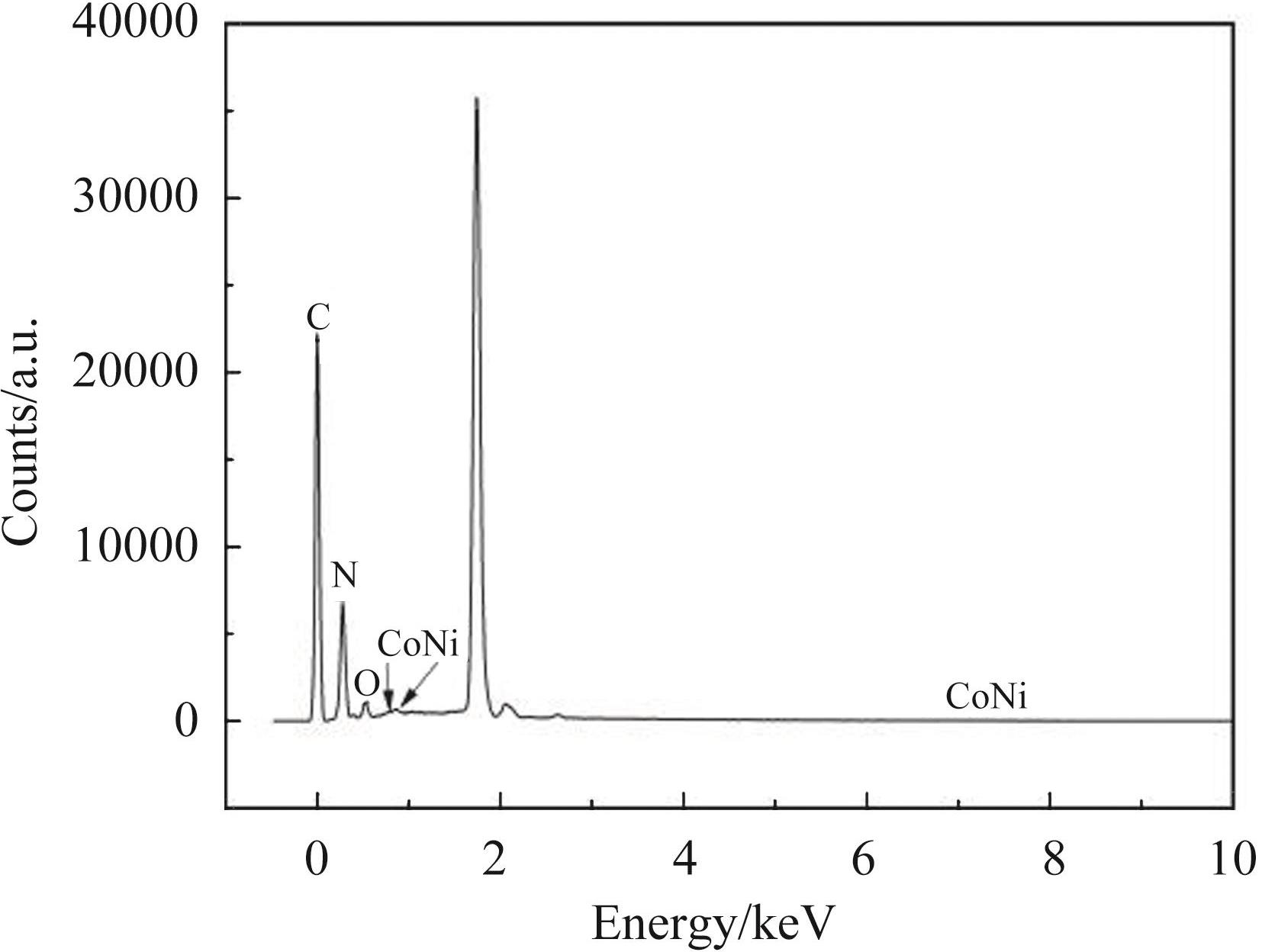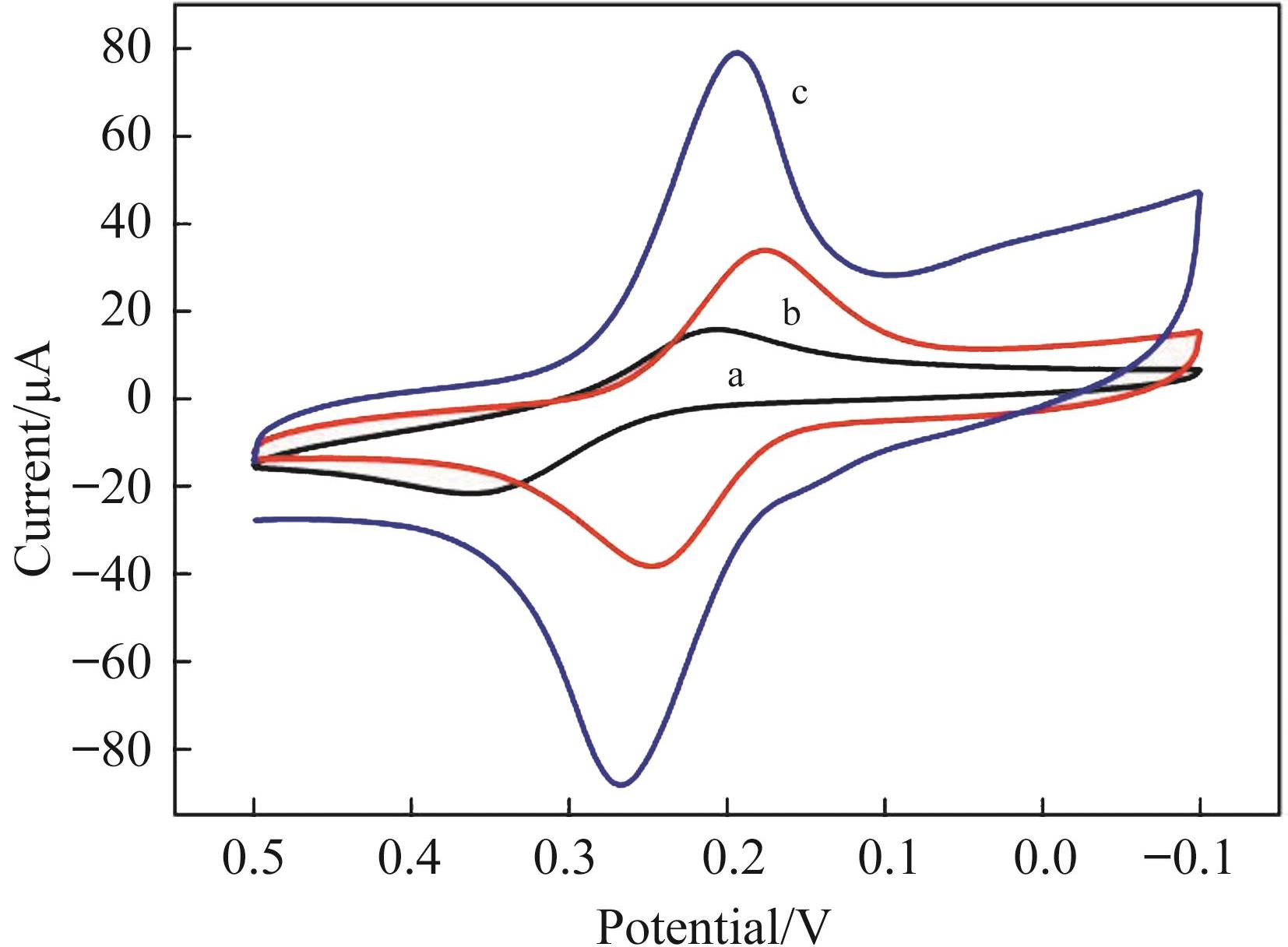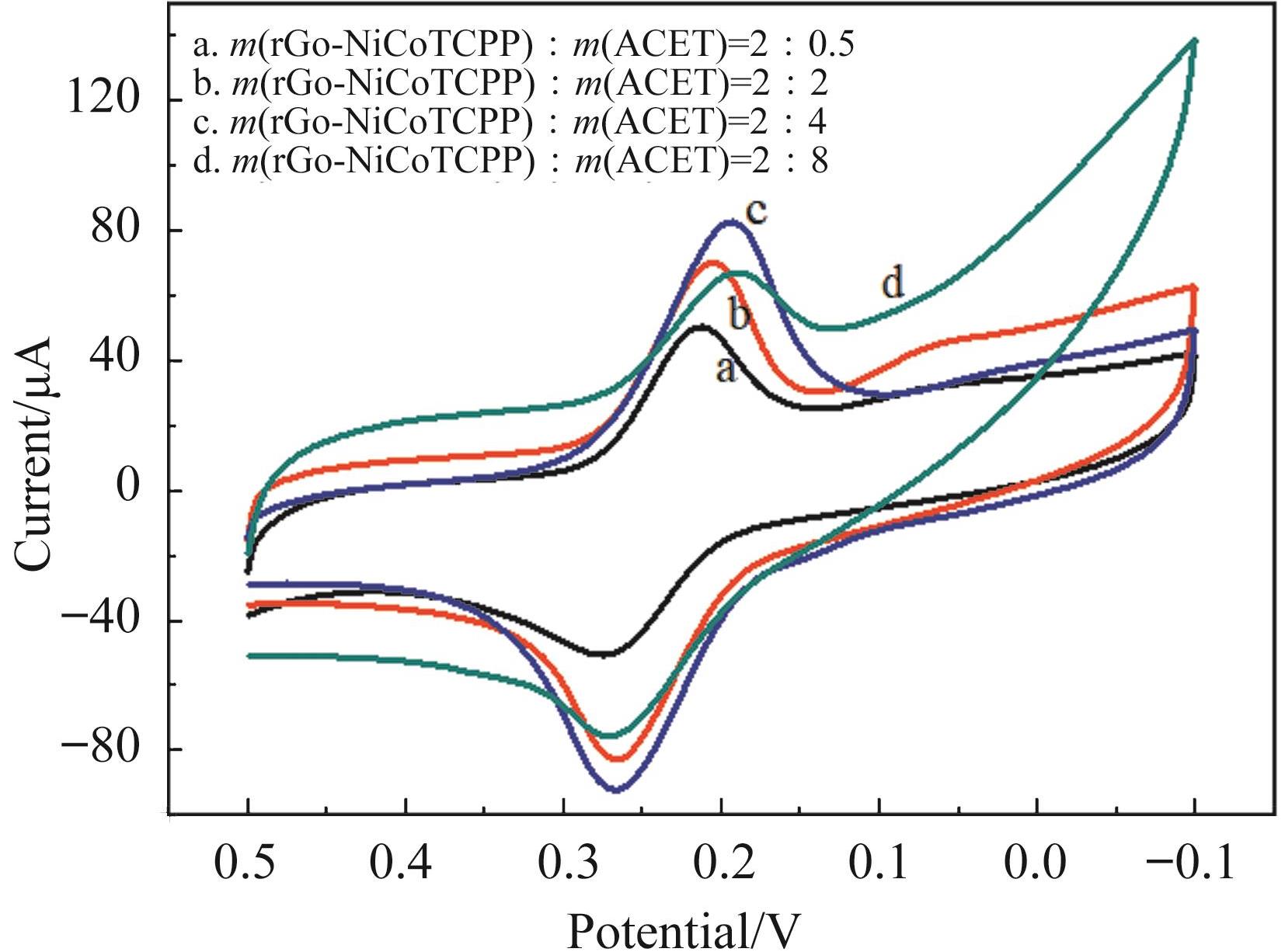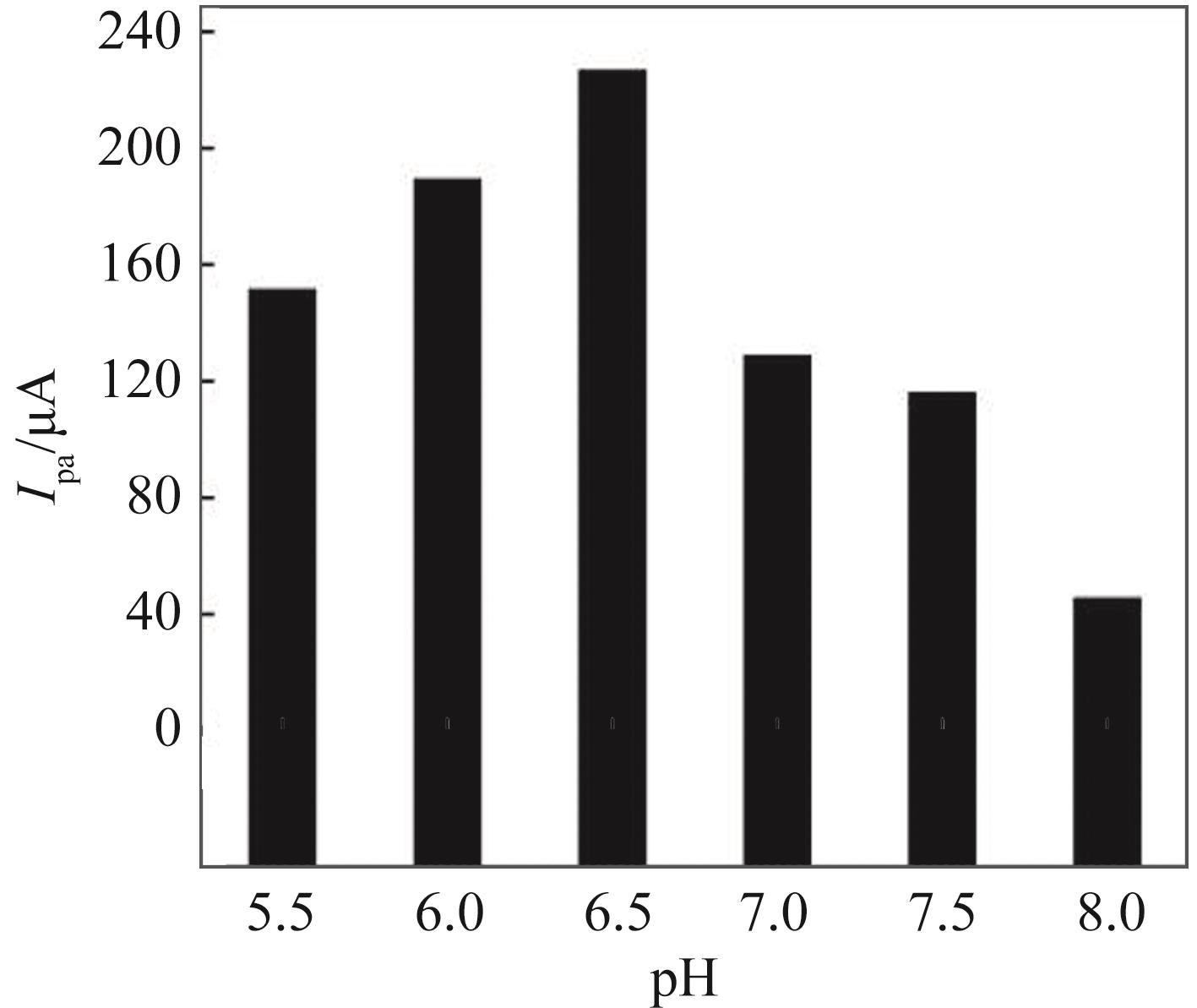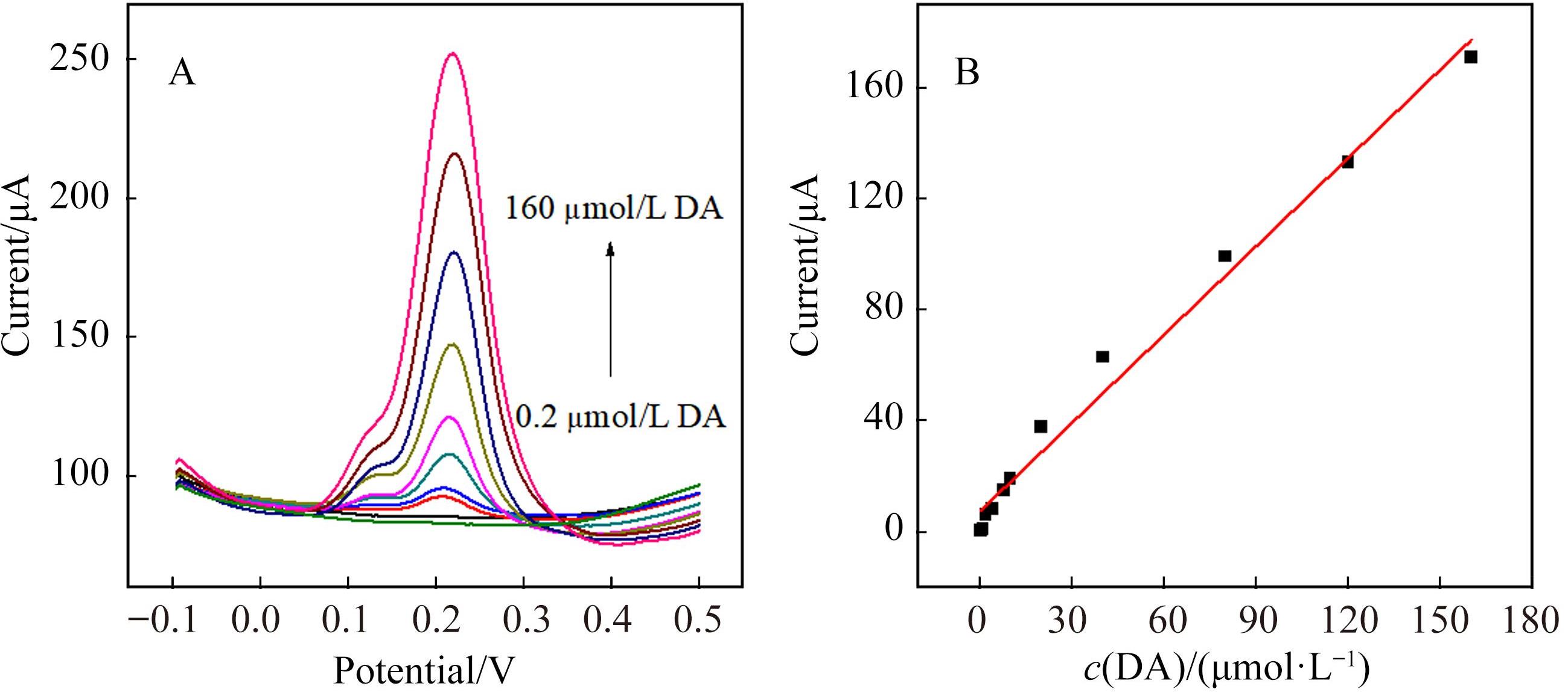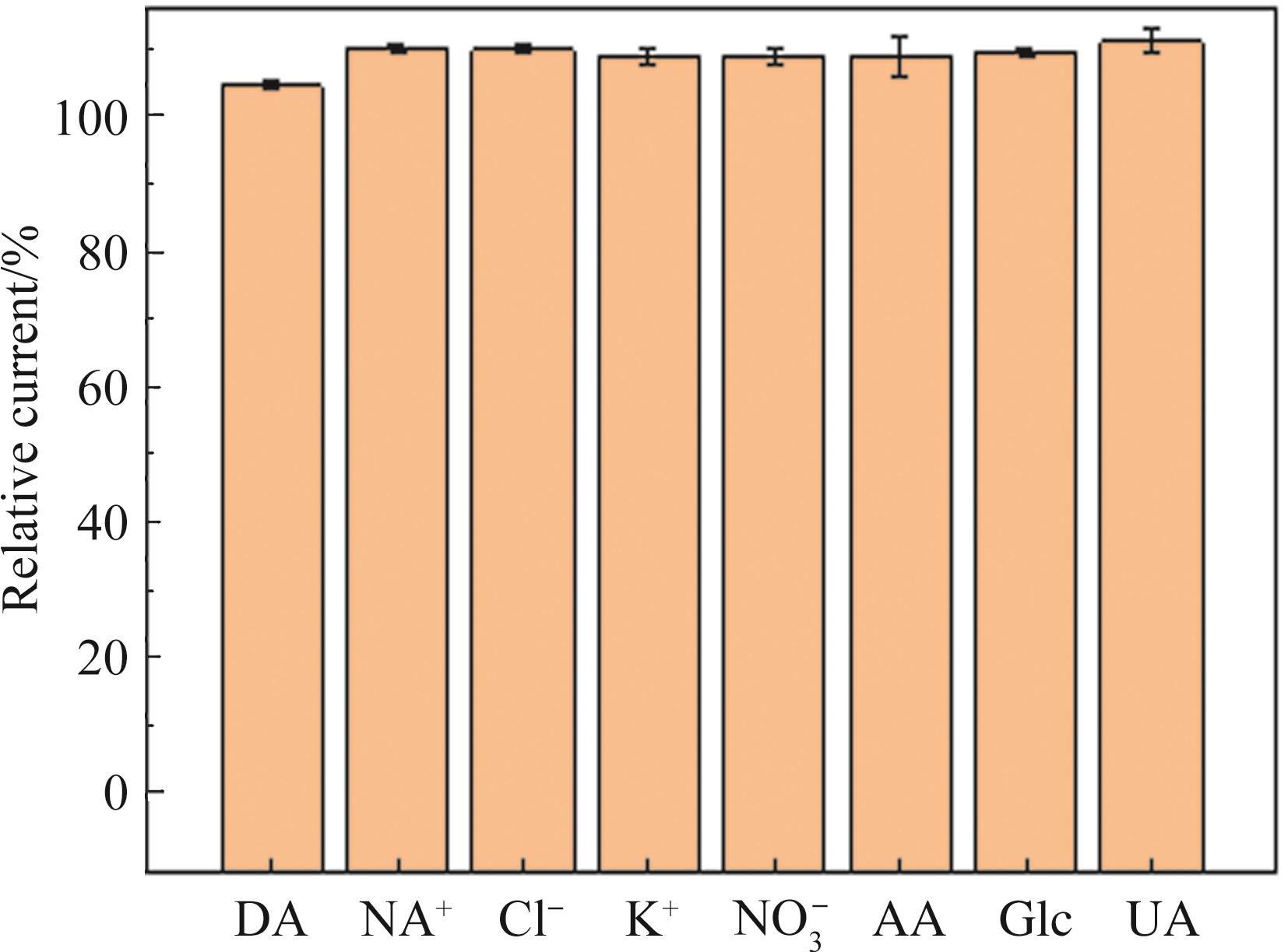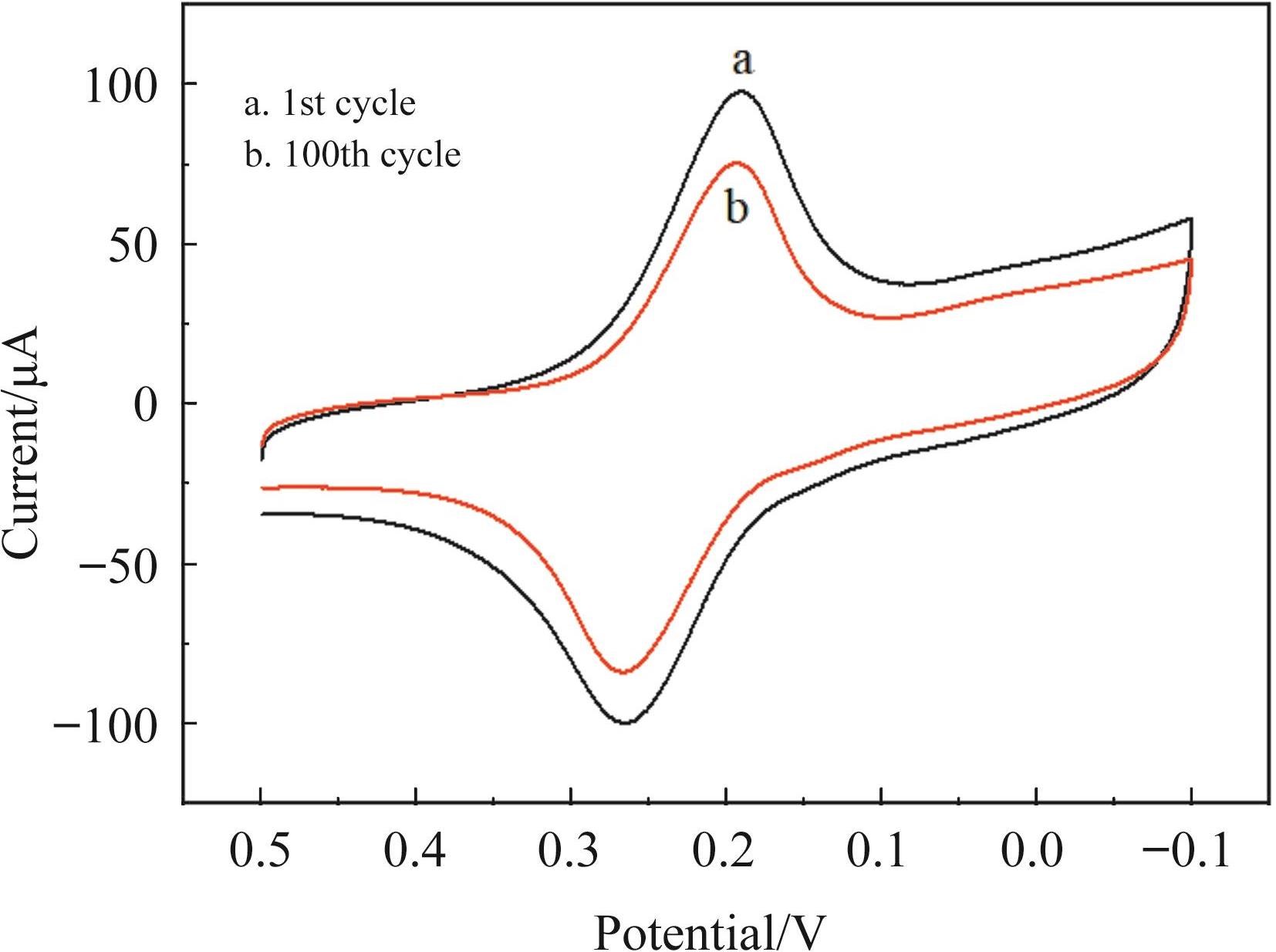
Chinese Journal of Applied Chemistry ›› 2022, Vol. 39 ›› Issue (7): 1098-1107.DOI: 10.19894/j.issn.1000-0518.210282
• Full Papers • Previous Articles Next Articles
Detection of Dopamine by Enzyme‑Free Sensor Constructed by Nickel‑Cobalt Bimetallic‑porphyrin Organic Framework Composites
Shan SHAO, Jian ZHANG, Kai-Qiang DENG, Jie YANG, Shao-Ming YANG( )
)
- School of Materials Science and Engineering,East China Jiaotong University,Nanchang 330013,China
-
Received:2021-06-10Accepted:2021-10-19Published:2022-07-01Online:2022-07-11 -
Contact:Shao-Ming YANG -
About author:yangsm79@ 163.com
-
Supported by:the National Natural Science Foundation of China(21465012)
CLC Number:
Cite this article
Shan SHAO, Jian ZHANG, Kai-Qiang DENG, Jie YANG, Shao-Ming YANG. Detection of Dopamine by Enzyme‑Free Sensor Constructed by Nickel‑Cobalt Bimetallic‑porphyrin Organic Framework Composites[J]. Chinese Journal of Applied Chemistry, 2022, 39(7): 1098-1107.
share this article
Add to citation manager EndNote|Ris|BibTeX
URL: http://yyhx.ciac.jl.cn/EN/10.19894/j.issn.1000-0518.210282
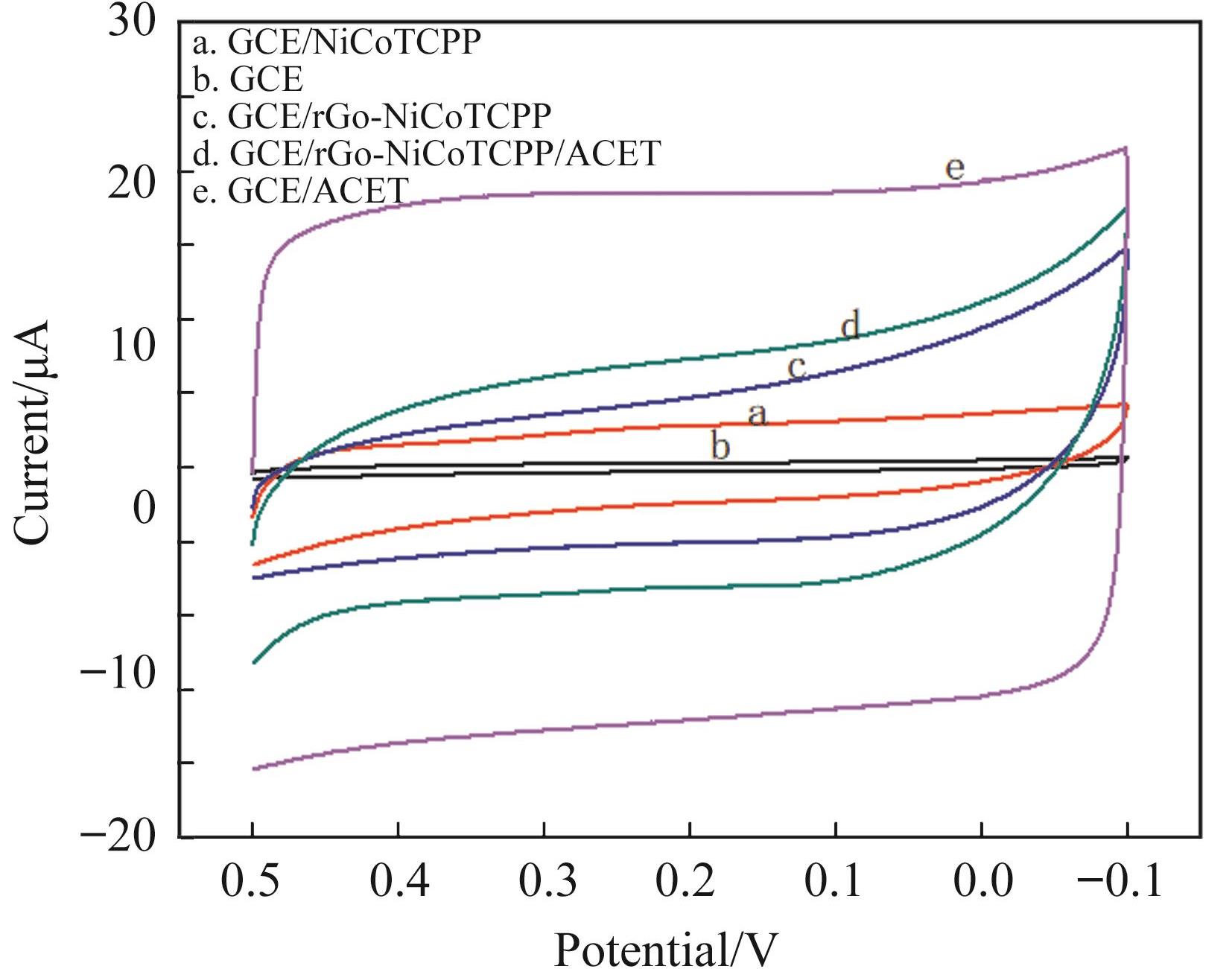
Fig.5 CV responses of different modified electrodes in PBS (0.2 mol/L PBS, pH=6.5)a.bare GCE; b.GCE/ NiCoTCPP; c.GCE/rGO-NiCoTCPP; d.GCE/rGO-NiCoTCPP/ACET;e.GCE/ ACET
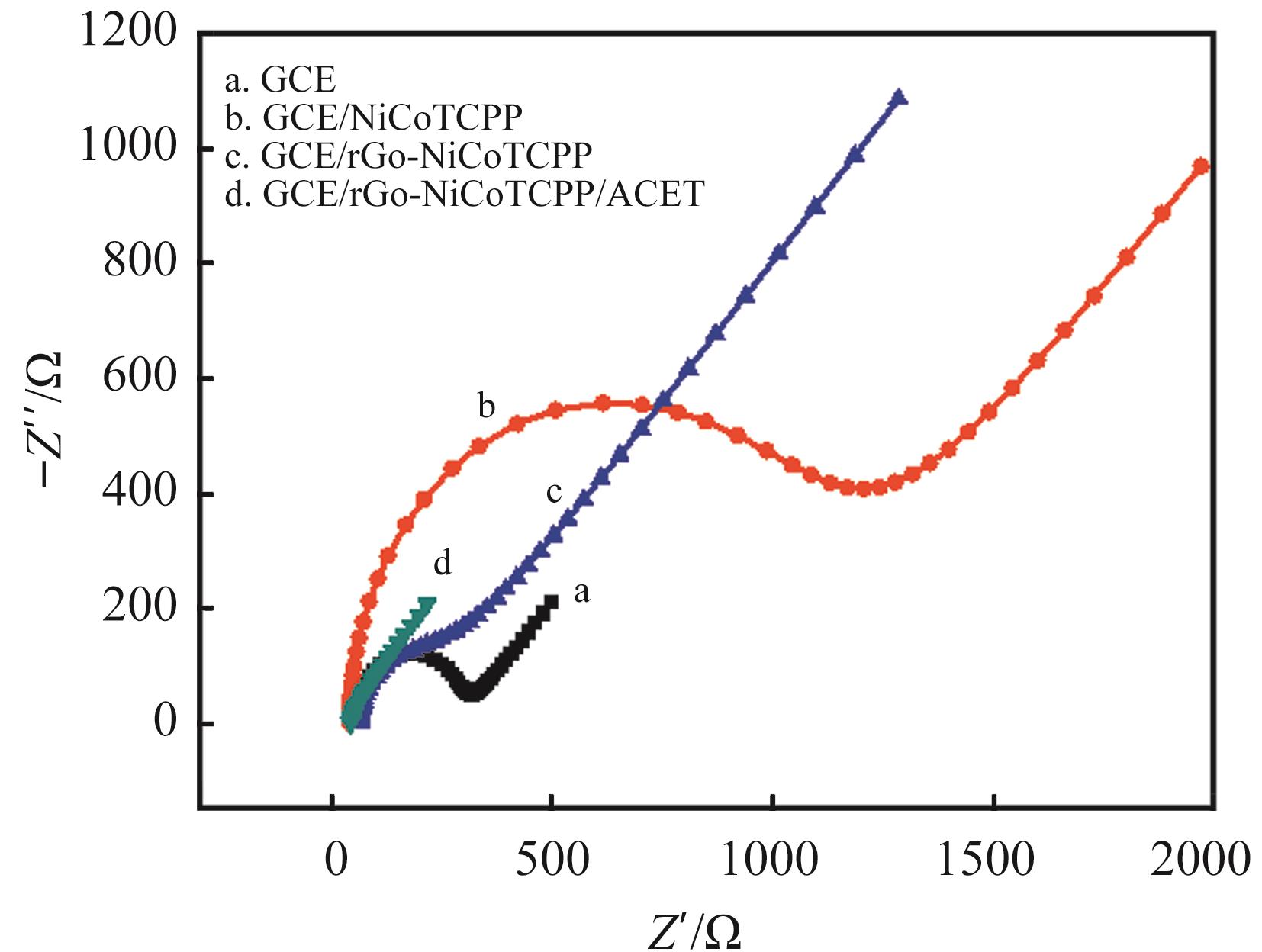
Fig.6 EIS response of sensor assembly process in 5 mmol/L K3[Fe(CN)6]/K4[Fe(CN)6] solution (containing 0.5 mol/L KCl)a. bare GCE; b. GCE /NiCoTCPP; c. GCE/rGO-NiCoTCPP; d. GCE/rGO-NiCoTCPP/ACET
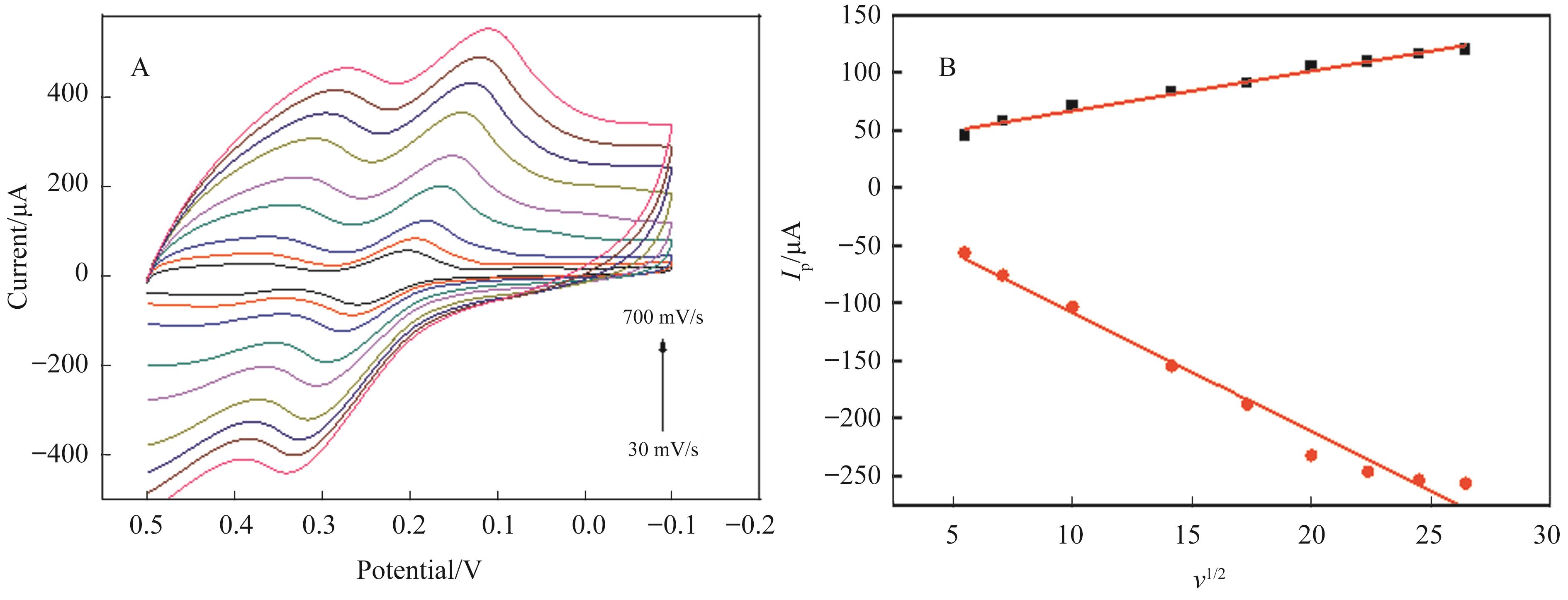
Fig.10 (A) CV response of GCE/rGO-NiTCPP at different scan rates ranging from 30 mV/s to 700 mV/s (30, 50,100, 200, 300, 400, 500, 600, 700 mV/s); (B) Linear fit of peak current and sweep speed
材料 Material | DA检测限 | DA线性范围 | 参考文献 Ref. |
|---|---|---|---|
| DA LOD/(μmol·L-1) | DA linear range/(μmol·L-1) | ||
片层石墨柱电极 Sheet graphite column | 0.446 0.005 4.580 | 5~400 | |
玻璃密封金纳米电极 Au/GSNE | 10~2550 | ||
基于P2W16V2和Au/Pd传感复合膜 Au/Pd HNRs | — | [ | |
超薄Co3O4纳米片修饰电极 Ultra?thin Co3O4 nanowires | 0.060×10-3 | 1.0×10-3~1.0×104 | [ |
手性金属有机框架HMOF? Zn@乙炔黑玻碳电极 HMOF?Zn@AB?Nafion?GCE | 0.003 | 0.15~2.5 | [ |
石墨烯?镍钴卟啉有机金属框架/乙炔黑玻碳电极 GCE/rGO?NiCoTCPP/ACET | 0.198 | 0.4~160 | 本工作 This work |
Table 1 DA detection by other sensors
材料 Material | DA检测限 | DA线性范围 | 参考文献 Ref. |
|---|---|---|---|
| DA LOD/(μmol·L-1) | DA linear range/(μmol·L-1) | ||
片层石墨柱电极 Sheet graphite column | 0.446 0.005 4.580 | 5~400 | |
玻璃密封金纳米电极 Au/GSNE | 10~2550 | ||
基于P2W16V2和Au/Pd传感复合膜 Au/Pd HNRs | — | [ | |
超薄Co3O4纳米片修饰电极 Ultra?thin Co3O4 nanowires | 0.060×10-3 | 1.0×10-3~1.0×104 | [ |
手性金属有机框架HMOF? Zn@乙炔黑玻碳电极 HMOF?Zn@AB?Nafion?GCE | 0.003 | 0.15~2.5 | [ |
石墨烯?镍钴卟啉有机金属框架/乙炔黑玻碳电极 GCE/rGO?NiCoTCPP/ACET | 0.198 | 0.4~160 | 本工作 This work |
样品 Sample | 稀释后DA的含量 The amount of DA after dilution | 加标量 Spiked/(μmol·L-1) | 回收量 Recycle/(μmol·L-1) | 回收率 Recovery/% |
|---|---|---|---|---|
| 1 | 未检出 Not detected | 10 | 9.6 | 96.0 |
| 2 | 未检出 Not detected | 20 | 20.5 | 102.5 |
| 3 | 未检出 Not detected | 60 | 61.8 | 103.3 |
Table 2 Recovery of DA
样品 Sample | 稀释后DA的含量 The amount of DA after dilution | 加标量 Spiked/(μmol·L-1) | 回收量 Recycle/(μmol·L-1) | 回收率 Recovery/% |
|---|---|---|---|---|
| 1 | 未检出 Not detected | 10 | 9.6 | 96.0 |
| 2 | 未检出 Not detected | 20 | 20.5 | 102.5 |
| 3 | 未检出 Not detected | 60 | 61.8 | 103.3 |
| 1 | YANG C, ZHANG C Y, HUANG T, et al. Ultra-long ZnO/carbon nanofiber as free-standing electrochemical sensor for dopamine in the presence of uric acid[J].J Mater Sci, 2019, 54(24): 14897-14904. |
| 2 | LIU N, XIANG X, FU L, et al. Regenerative field effect transistor biosensor for in vivo monitoring of dopamine in fish brains[J]. Biosens Bioelectron, 2021, 188: 113340. |
| 3 | ZHANG X L, ZHU Y G, XIE L, et al. A simple, fast and low-cost turn-on fluorescence method for dopamine detection using in situ reaction[J].Anal Chim Acta, 2016, 944(9): 51-56. |
| 4 | RIBEIRO R P, GASPARETTO J C, RAQUEL D, et al. Simultaneous determination of levodopa, carbidopa, entacapone, tolcapone, 3-O-methyldopa and dopamine in human plasma by an HPLC-MS/MS method [J]. Bioanalysis, 2015, 7(2): 207-220. |
| 5 | KAYA M, VOLKAN M. New approach for the surface enhanced resonance raman scattering (SERRS) detection of dopamine at picomolar (pM) levels in the presence of ascorbic acid[J]. Anal Chem, 2012, 84(18): 7729-7735. |
| 6 | RASHEED P A, LEE J S. Recent advances in optical detection of dopamine using nanomaterials[J]. Microchim Acta, 2017, 184(5): 1-28. |
| 7 | 覃秀, 袁春玲, 石睿, 等. 基于碘刻蚀金纳米棒的比色法测定多巴胺[J]. 分析化学, 2021, 49(1): 60-67. |
| TAN X, YUN C L, SHI R, et al. Colorimetric detection of dopamine based on lodine-mediated etching of gold nanorods[J]. Chinese J Anal Chem, 2021, 49(1): 60-67. | |
| 8 | 周旋, 崔泽琳, 白雪峰. 构建多巴胺电化学传感器电极材料的研究进展[J]. 化学与粘合, 2021, 43(2): 138-142. |
| ZHOU X, CUI Z L, BAI X F. Research progress on construction of electrode materials for dopamine electrochemical sensors[J]. Chem Adhes, 2021, 43(2): 138. | |
| 9 | 王林玉, 洪莎莎, 黎艳艳, 等. 三维多孔碳/共价有机框架材料自支撑电极用于多巴胺电化学传感分析[J]. 分析化学, 2021, 49(6): 1053-1060. |
| WANG L Y, HONG S S, LI Y Y, et al. Dopamine electrochemical sensor based on three-dimensional macroporous carbon/covalent organic framework integrated electrode[J].Chinese J Anal Chem, 2021, 49(6): 1053-1060. | |
| 10 | 许晓迪, 孟伟, 戴磊. 片层石墨柱电极制备及其对多巴胺的电化学检测[J]. 分析试验室, 2020, 39(6): 621-625. |
| XU X D, MENG W, DAI L. Preparation of sheet graphite column electrode and its electrochemical detection of dopamine[J]. Chinese J Anal Lab, 2020, 39(6): 621-625. | |
| 11 | DING S S, LIU Y Z, MA C R, et al. Development of glass-sealed gold nanoelectrodes for in vivo detection of dopamine in rat brain[J]. Electroanal, 2018, 30(6): 1041-1046. |
| 12 | CHEN X L, ZHANG G W, HE Y, et al. A sensitive electrochemical sensor based on Au@Pd hybrid nanorods supported on B-doped graphene for simultaneous determination of acetaminophen, dopamine and tyrosine[J]. Int J Electrochem Soc, 2020, 15(6): 5927-5944. |
| 13 | ELHANG S, IBUPOTO Z H, LIU X J, et al. Sensor dopamine wide range detection sensor based on modified Co3O4 nanowires electrode[J]. Sens Actuators B: chem, 2014, 203(1): 543-549. |
| 14 | 方智利, 王平, 刘胜东, 等. 基于手性 MOF 与乙炔黑修饰电极对多巴胺和尿酸的同时检测[J]. 无机化学学报, 2020, 36(1): 139-147. |
| FANG Z L, WANG P, LIU S D, et al. Simultaneous detection of dopamine and uric acid based on chiral MOF and acetylene black modified electrode[J]. Chinese J Inorg Chem, 2020, 36(1): 139-147. | |
| 15 | HAN Y Z, WU Y Z, LAI W Z, et al. Electrocatalytic water oxidation by a water-soluble nickel porphyrin complex at neutral pH with low overpotential[J]. Inorg Chem, 2015, 54(11): 5604. |
| 16 | ZHAO S L, WANG Y, DONG J C,et al. Ultrathin metal-organic framework nanosheets for electrocatalytic oxygen evolution[J]. Nat Energy, 2016, 1(12): 1-10. |
| 17 | YANG H, YIN D X, GAO L N, et al. 5,10,15,20-Tetrakis(4-carboxylphenyl)porphyrin modified nickel-cobalt layer double hydroxide nanosheets as enhanced photoelectrocatalysts for methanol oxidation under visible-light[J]. J Colloid Interface Sci, 2019, 561: 881-889. |
| 18 | AHRENHOLT S R, EPLEY C C, MORRIS A J. Solvothermal preparation of an electrocatalytic metalloporphyrin MOF thin film and its redox hopping charge-transfer mechanism[J]. J Am Chem Soc, 2014, 136(6): 2464-2472. |
| 19 | MARTIN P. Heteroatom modified graphenes: electronic and electrochemical applications[J]. J Mater Chem C, 2014, 2(32): 6454-6461. |
| 20 | WEN Y, MENG W, LI C, et al. An enhanced glucose sensing based on a novel composite of CoII-MOF/Acb modified electrode[J]. Dalton Trans, 2018, 47(11): 3872-3879. |
| 21 | QIU X N, CAI H, FANG X, et al. The improved thermal oxidative stability of silicone rubber by incorporating reduced graphene oxide: impact factors and action mechanism[J]. Polym Compos, 2018, 39(4): 1105-1115. |
| 22 | 宋正恩. 系列卟啉化合物的合成与表征[D]. 兰州: 西北师范大学, 2010. |
| SONG Z E. Synthesis and characterization of porphyrin compounds[D]. Lanzhou: Northwest Normal University, 2010. | |
| 23 | YIN D D, LIU J, BO X J, et al. Porphyrinic metal-organic framework/macroporous carbon composites for electrocatalytic applications[J]. Electrochim Acta, 2017, 247(1): 41-49. |
| 24 | KU S, PALANISAMY S, CHEN S M. Highly selective dopamine electrochemical sensor based on electrochemically pretreated graphite and nafion composite modified screen printed carbon electrode[J]. J Colloid Interfaces Sci, 2013, 411: 182-186. |
| [1] | Ning YUAN, Jie MA, Jin-Ling ZHANG, Jian-Sheng ZHANG. Preparation of PCN-6(M) Bimetallic Organic Framework Materials by Steam-assisted Method and Their CO2 and CH4 Adsorption Performance [J]. Chinese Journal of Applied Chemistry, 2023, 40(6): 896-903. |
| [2] | Nan-Yu LIN, Feng GAO, Jiang-Ying QU, Jing-Jing TU, Wei-Jun ZHONG, Yun-Hao ZANG. Preparation of Super-hydrophilic/Underwater Oil-phobic High Silicon Cloth and Its Oil-water Separation Performance [J]. Chinese Journal of Applied Chemistry, 2023, 40(3): 449-459. |
| [3] | Dong-Dong LI, Li QIN, Lu-Hua TANG, Wen-Hui GAO. Preparation and Application of Basic OrangeⅡImprinted Sensor [J]. Chinese Journal of Applied Chemistry, 2022, 39(7): 1052-1064. |
| [4] | Zhen-Hua LI, Ying ZHU, Jing CHEN, Shi-Ping SONG. Advances in Construction and Electrochemical Biosensing of Antifouling Interfaces [J]. Chinese Journal of Applied Chemistry, 2022, 39(5): 736-748. |
| [5] | Li QIN, Xiao-Ting YOU, Lu-Hua TANG, Jian-Wen LI, Yin ZHANG, Wen-Hui GAO, Jun-Hua HAN. Preparation and Application of Auramine O Imprinted Sensor Based on Nanomaterials Modification [J]. Chinese Journal of Applied Chemistry, 2022, 39(12): 1880-1890. |
| [6] | ZHANG Meng, CHEN Dong-Zhen, REN Yan-Wei, NING Pan. Sensing Interface Based on Nanoislandlike Sliver Film@Gold Nanotip for Surface Enhanced Raman Scattering Analysis of Dopamine [J]. Chinese Journal of Applied Chemistry, 2021, 38(7): 866-873. |
| [7] | ZHANG Jingjing, XIAO Xin, SHI Dongjian, CHEN Mingqing. Morphology Regulation of Polydopamine Self-polymerization on the Surface of Strongly Electronegative Microspheres [J]. Chinese Journal of Applied Chemistry, 2020, 37(7): 756-763. |
| [8] | QIN Sinan, TANG Luhua, GAO Wenhui. Cyhalothrin Molecularly Imprinted Electrochemical Sensor:Preparation, Performance and Application [J]. Chinese Journal of Applied Chemistry, 2019, 36(8): 958-967. |
| [9] | XING Chenli, WANG Jing, ZHANG Zhaohui, XIE Dandan, LÜ Piaopiao. Multiple Metal Ion Imprinted Electrochemical Sensor with Enhanced Sensitivity by Graphene Oxide-C60 Composite [J]. Chinese Journal of Applied Chemistry, 2019, 36(3): 341-348. |
| [10] | WANG He, LUO Jing, LI Xiaojie, SHI Dongjian, CHEN Mingqing. Efficient Preparation of Polydopamine Nanoparticles by Precipitation [J]. Chinese Journal of Applied Chemistry, 2019, 36(2): 155-160. |
| [11] | ZHANG Zhuying,CHEN Jing,YU Jialei,ZHAO Qian,CAO Chuanhao,SHEN Jiali,SHI Dongjian. Preparation and Properties of Polydopamine and Alginate Porous Complex Scaffolds [J]. Chinese Journal of Applied Chemistry, 2018, 35(6): 665-673. |
| [12] | Shuang LENG, Tao WANG, Min YANG, Yanzhi ZHAO, Wei LU, Ruoming WANG, Guoying SUN. Preparation and Electrochemical Performance of Nitrogen Doped Carbon Materials Based on Polydopamine [J]. Chinese Journal of Applied Chemistry, 2018, 35(4): 477-483. |
| [13] | XIE Dandan, YAN Liang, YIN Yuli, ZHANG Zhaohui, WANG Jing. Preparation and Application of Magnetic Multi-ion Imprinted Polymers Based on Multiwalled Carbon Nanotubes [J]. Chinese Journal of Applied Chemistry, 2017, 34(4): 456-463. |
| [14] | DING Hao, YAN Fei, ZHENG Wenjing, GUO Weiliang, SU Bin. Electrochemical Detection of Antioxidants in Cosmetic Samples Using Mesoporous Silica Film and Confined Micelles [J]. Chinese Journal of Applied Chemistry, 2017, 34(11): 1307-1313. |
| [15] | DING Hao, YAN Fei, ZHENG Wenjing, GUO Weiliang, SU Bin. Electrochemical Detection of Antioxidants in Cosmetic Samples Using Mesoporous Silica Film and Confined Micelles [J]. Chinese Journal of Applied Chemistry, 2017, 34(11): 0-0. |
| Viewed | ||||||
|
Full text |
|
|||||
|
Abstract |
|
|||||
